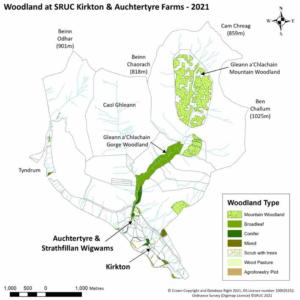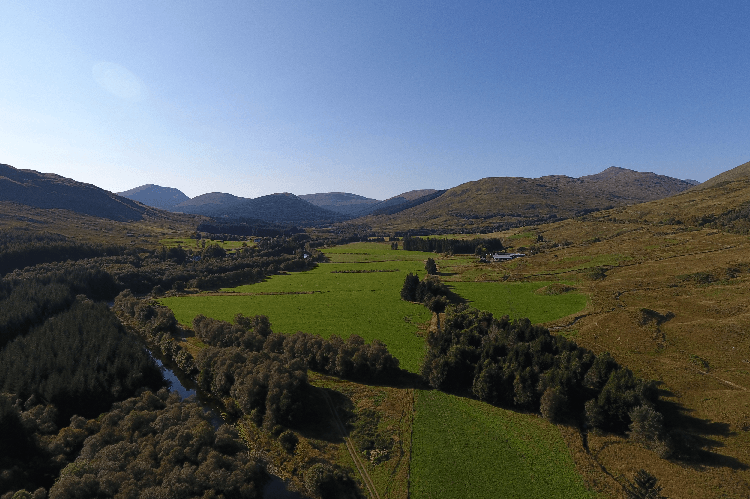Woodland at SRUC Kirkton & Auchtertyre (FWN37 Autumn 2021)
13 December 2021SRUC’s Kirkton and Auchtertyre farms are situated between the villages of Tyndrum and Crianlarich in west Perthshire; at the northern edge of the Loch Lomond and the Trossachs National Park. The estate is a centre for research and demonstration into sustainable land management in hill and mountain areas; and is the location for SRUC’s Hill and Mountain Research Centre.
Back in 1995 there was very little woodland on the estate, with only a few small conifer and mixed woodland blocks and shelterbelts on the inbye ground, and some remnant semi-natural woodland in two steep sided gorges and along the banks of the River Fillan. Over the past 25 years the woodland cover on the estate has increased by over 270 hectares, including 3 ha of native Scots pine woodland, 43 ha of native broadleaved woodland and over 200 ha of mountain woodland and scrub, as well as some shelterbelts and riparian planting on the inbye ground, and a small agroforestry plot.
Most of the woodland on the estate has been planted for biodiversity and landscape reasons or for shelter, rather than for timber production. We are hoping to plant more woodland, with proposals to plant approximately 10 ha of mixed woodland or commercial broadleaf for timber production (as well as for shelter, biodiversity and carbon storage), on an area of semi-improved grassland below the West Highland Railway line (200-250m). We are also looking at the possibility of fencing off a steep-sided gorge to the north of Tyndrum, to allow natural regeneration of the remnant Downy Birch, Willow and Rowan.
Gleann a’Chlachain Woodland
Three blocks of native woodland covering 260 ha of hill ground were planted in the late 1990s, with the original aim of eventually creating a silvopastoral system with managed sheep grazing within the two higher altitude woodland blocks.
The first phase of planting was along the Allt Gleann a‘Chlachain gorge (43 ha; 220-380m above sea level). The main purpose of this gorge woodland was to act as a wildlife corridor linking an area of existing semi-natural woodland in the lower part of the gorge with the main woodland planting in the upper bowl of Gleann a’Chlachain. More than 93,000 trees were planted in the gorge woodland between 1998 and 2009. The main species were Downy Birch, Silver Birch, Grey Willow, Alder, Scots Pine, Sessile Oak, Goat Willow, Rowan and Ash. Monitoring of the gorge woodland in the summer of 2021 found that the mean tree height was 3.97 m, and the average stocking density was approximately 1500 trees per hectare.
The main phase of woodland planting, which started in 1999, involved a large, fenced area in the bowl of Gleann a’Chlachain (181 ha; 390-600 m above sea level) and a smaller block on the north-west facing flank of Ben Challum (36 ha; 360-610 m above sea level). Over 390,000 trees were planted in the two blocks between 1999 and 2009. More than half the trees were Downy Birch, with the other main species being Silver Birch, Scots Pine, Alder, Rowan, Grey Willow, Goat Willow, Hazel and Eared Willow. The site was mounded prior to planting. Approximately 90% of the trees were bare rooted with 10% cell grown.
Eighty-eight percent of the trees came from four large nurseries in the east of Scotland with the rest coming from a local nursery in Argyll. Tree establishment has been relatively poor in the main woodland block and losses have been high. Our aspiration to allow controlled grazing within the woodland has not been realized due to the very slow rate of growth and poor establishment of the trees, together with an outbreak of enzootic abortion within the Gleann a’Chlachain flock, which resulted in the removal of the sheep from the glen in the autumn of 2008. This has meant that rather than creating a silvopastoral system we have created more of a “rewilded” glen with a large fenced “mountain woodland” and low levels of grazing outside the enclosure. Although many of the trees have been slow to establish and remain short in stature (many of them less than 1.0 m tall), their low, prostrate, bushy growth form, which has developed in response to the environmental and biological conditions, is entirely appropriate and expected at the altitudes involved.
Monitoring of the main woodland block in the summer of 2021 found that the mean tree height was only 1.04 m (maximum height of 7.5 m), and the average stocking density was approximately 685 trees per hectare. Of the main species, the Alder tended to be the tallest with Rowan and Willow being the shortest. We are now beginning to see the development of a mountain woodland of low growing trees and shrubs with extensive open areas of heath, bog and grassland, creating a diverse and species-rich habitat, which has improved the landscape, is acting as a carbon store and is reducing the risk of flooding lower down the catchment.
Small-scale Tree Planting on the Inbye Ground
Shelterbelts
As part of the Scottish Government’s Agri-environment and Climate Scheme two shelterbelts were created on the inbye ground at Kirkton in 2016, each one with 165 native broadleaf trees (Alder, Downy Birch, Hazel, Hawthorn, Bird Cherry, Sessile Oak, Goat Willow, Grey Willow, Eared Willow, Rowan, Crab Apple and Blackthorn). The trees were protected by tubes and the shelterbelt blocks were deer fenced. These shelterbelts will provide invaluable shelter for the ewes and lambs using the adjacent inbye fields, particularly during lambing. They will also provide habitat for a range of invertebrates, birds and mammals, and potentially provide wood products such as firewood.
Wood Pasture and Riparian planting
In 2017, three small-scale tree planting projects were carried out with support from the Loch Lomond and the Trossachs National Park’s Natural Heritage Grant Scheme. Ten tree protection boxes were constructed in a small area of wood pasture with scattered mature Downy Birch trees. These tree boxes were post and rail enclosures, with a barbed wire top, which protect the planted Downy Birch trees from sheep, cattle and deer browsing. In another area of mature Downy Birch wood pasture, beside the River Fillan at Auchtertyre, thirty Downy Birch and Rowan saplings were planted in individual weld-mesh cages. Within one of the fenced water margins on the inbye ground a further forty riparian trees were planted, in groups of eight trees (a mix of Goat Willow, Grey Willow and Alder).
Agroforestry Plot
In March 2020 a small half hectare block of agroforestry was established with funding from the Loch Lomond and the Trossachs National Park’s Tree Planting Grant. One hundred individually protected trees were planted at approximately 7 m spacing in a block five trees wide and 20 trees long. A mix of native tree species were planted; Alder, Downy Birch, Aspen, Cherry, Pedunculate Oak, Sessile Oak and Rowan. The trees were individually protected using a 1.5 m high cage made from 2 mm gauge weld mesh with 50 mm squares and a ‘cage’ diameter of 45 cm. This was supported by two wooden posts. Each tree was protected by a vole guard and was given 12 g of high phosphate tree fertilizer. The cages provide the trees with protection from browsing, but the sheep are still able to graze the pasture between the trees. The avenues between the tree rows are wide enough for a tractor so that fertilizer can still be spread onto the grass if required. The LLTNP Grant of £1500 covered the cost of materials (with a cost per cage of £15.95 (incl. VAT)). The labour costs were calculated to be £10.46 per cage. The Tree Planting Grant offers financial assistance (up to £3000) to land managers in the National Park who want to plant individual trees or small areas of woodland that might not usually be eligible for other funding. One of the priority outcomes that the grant scheme supports is the enhancement of tree integration into agricultural systems (agroforestry). If support under the FGS agroforestry option had been sought this would only have provided a grant of £9.30 per tree, plus an annual management grant of £24. The site will be used both for demonstration and research purposes, showing farmers and land managers how agroforestry can be integrated into a hill farm system. This small block of silvopastoral agroforestry will provide multiple benefits, including shelter and shade for the livestock, tree forage, timber and firewood, improved drainage and better soil health, carbon storage, and habitat for woodland invertebrates and birds.
A map of the woodland resources at SRUC Kirkton & Auchteryre (2021)
Dr John Holland, Upland Ecologist, SRUC Hill and Mountain Research Centre
This article has been published in the Autumn 2021 edition of the Farm Woodland News. Download a copy to access all articles. Subscribe to receive newly published editions via email by using the form here.
Sign up to the FAS newsletter
Receive updates on news, events and publications from Scotland’s Farm Advisory Service


